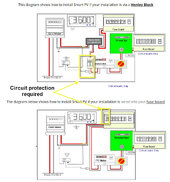Ranging6880
New Member
Hi,
First time poster, but been lurking/reading for quite some time.
I've installed a battery system (PV to follow), but cannot get the inverter to detect the grid. Installation is as in the attached sketch.
If transfer is set to (2), and Rotary Isolator to "Off" then CU and loads all receive power as expected. If the transfer switch is set to (1) and Rotary Isolator to "On", then the inverter will supply the CU and loads from the battery. However, on this setting, the inverter also reports "Grid not detected".
Inverter recognises the Arcel meter installed (on Live between DNO cutout and meter) and reports RS485 communication with the meter OK.
Transfer switch supplies Inverter into AC-Grid; AC-Backup goes to rotary isolator and then on to the CU.
Can anyone help me troubleshoot this?
Thank you
First time poster, but been lurking/reading for quite some time.
I've installed a battery system (PV to follow), but cannot get the inverter to detect the grid. Installation is as in the attached sketch.
If transfer is set to (2), and Rotary Isolator to "Off" then CU and loads all receive power as expected. If the transfer switch is set to (1) and Rotary Isolator to "On", then the inverter will supply the CU and loads from the battery. However, on this setting, the inverter also reports "Grid not detected".
Inverter recognises the Arcel meter installed (on Live between DNO cutout and meter) and reports RS485 communication with the meter OK.
Transfer switch supplies Inverter into AC-Grid; AC-Backup goes to rotary isolator and then on to the CU.
Can anyone help me troubleshoot this?
Thank you






